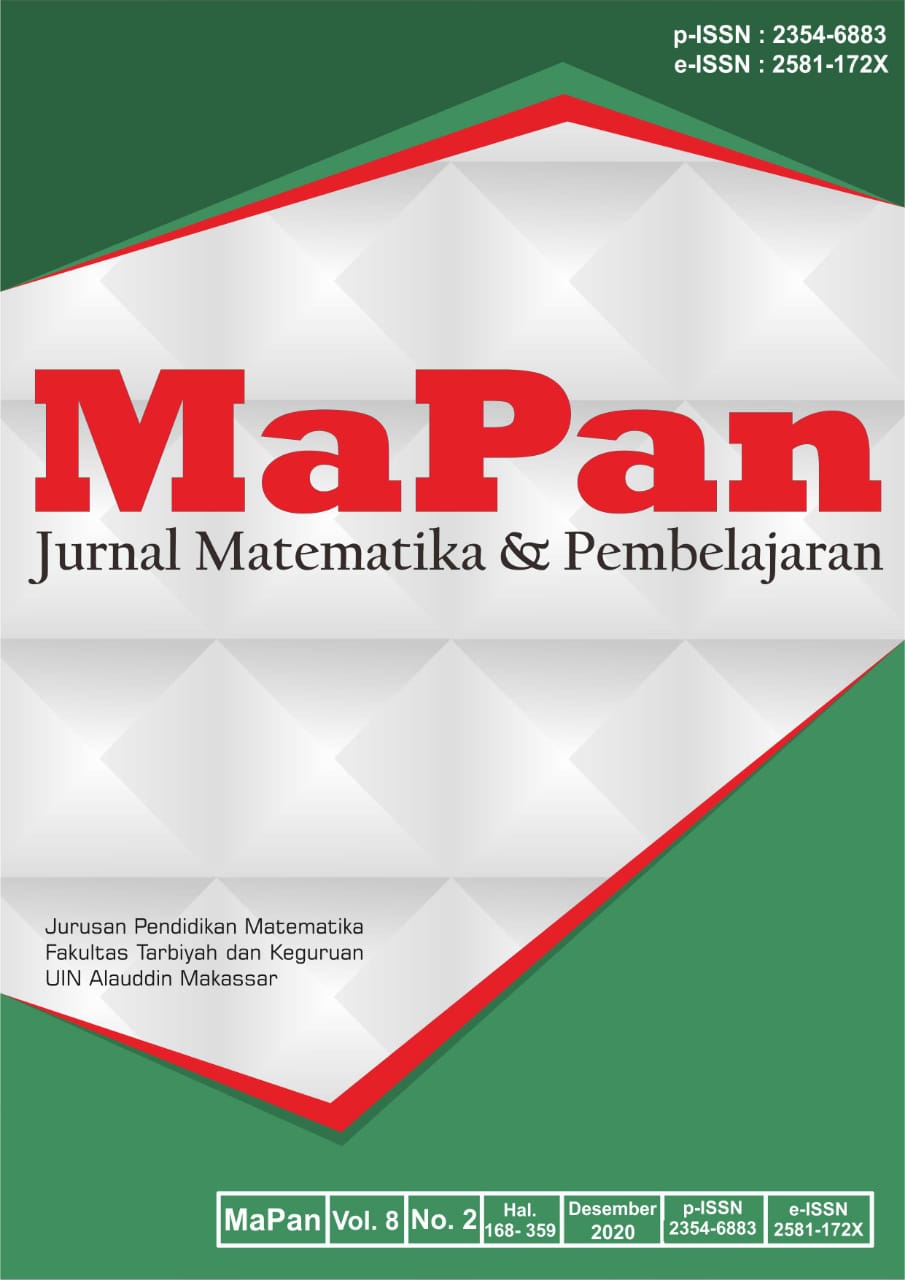SELF-EFFICACY: ANALYSIS OF LEARNING OUTCOMES OF TEACHER EDUCATION PROFESSIONALS (PPG)
Abstract
Self-Efficacy (SE) is an essential component in mathematics learning that must be improved so that the teaching performance can convince students. The purpose of this study is how brightspace SPADA (Online Learning System) is developed to measure PPG participants' self-efficacy, which can contribute to the creation of an increase in the quality of education. This study's subjects were PPG participants in the Department of Mathematics Studies in one private LPTK in Bandung, which before the workshop began with online learning. The research method used is the Mixed Method of Embedded Design type and Embedded Experimental Model type. The instrument used was an online test on e-learning and a closed statement SE scale of 10. The analysis used include, (1) Descriptive analysis of online learning outcomes and self-efficacy, (2) Comparative analysis of online learning outcomes between classes (Class A and B) using the Mann Whiney-U test because the data are not normally distributed, (3) Comparative analysis of online learning outcomes between levels, namely junior high, high school, and vocational school (SMP, SMA, and SMK) using ANOVA, (4) Comparative analysis of self-efficacy between classes (Classes A and B) using t-test, because the data is normally distributed, (5) Comparative analysis self-efficacy between levels (SMP, SMA, and SMK) using ANOVA, (6) Analysis of the effect of online learning outcomes on self-efficacy using simple linear regression. The study results are: (1) Descriptive online learning results can be concluded that PPG Mathematics online learning outcomes are above average (≥ 75), based on levels. The result of descriptive statistical data analysis of online learning outcomes is that the average value of participants from SMP, SMA, and SMK is 76.93, 93.12, and 85.92. PPG Mathematics participants' self-efficacy is in the very good category (8.6 from 0-10 intervals), based on the level. Descriptive statistical data analysis obtained the average value of participants from SMP, SMA, and SMK is 8.68, 8.65, and 8.76. (2) There is no significant difference in online learning outcomes between classes A and B. (3) There is no significant difference in online learning outcomes between SMP, SMA, and SMK. (4) There is no significant difference in self-efficacy between classes A and B. (5) There is no significant difference in self-efficacy between SMP, SMA, and SMK. (6) There is no online learning outcomes influence on Self-Efficacy.Downloads
References
Akay, H., & Boz, N. (2010). The effect of problem posing oriented analyses-II course on the attitudes toward mathematics and mathematics self-efficacy of elementary prospective mathematics teachers. Australian Journal of Teacher Education, 35(1), 1–17. https://doi.org/10.14221/ajte.2010v35n1.6.
Bandura. (2008). Self-efficacy. Retrieved from http://www.des.emory.edu/mfp /BanEncy.html.
Darta. (2014). Self efficacy dalam pembelajaran matematika. Symmetry 3 (Pendidikan Matematika), 3(1), 328–333.
Darta, & Saputra, J. (2018). Indicators that influence prospective mathematics teachers representational and reasoning abilities. Journal of Physics: Conference Series, 948(1). https://doi.org/10.1088/17426596/948/1/012053.
Effendi, R. (2018). Brightspace: software e-learning bagi guru PPG dalam jabatan 2018. Kompasiana. Retrieved from https://www.kompasiana.com/ridwaneffendi8466/5b15644abde57504a63ab092/e-learning-brightspace -untuk-guru-peserta-ppg-dalam-jabatan-2018.
Holzberger, D., Philipp, A., & Kunter, M. (2013). How teachers’ self-efficacy is related to instructional quality: A longitudinal analysis. Joumal of Educational Psychology. Joumal of Educational Psychology, 5(3), 774–786. https://doi.org/10.1037/a0032l98.
Indrawan, R., & Yaniawati, P. (2014). Metodologi penelitian kuantitatif, kualitatif, dan campuran untuk manajemen, pembangunan, dan pendidikan. Bandung: PT Refika Aditama.
Maulana, G. G., & Saputra, J. (2018). Penggunaan metode pembelajaran outdoor learning untuk meningkatkan hasil belajar siswa pada subkonsep vertebrata. BIOSFER: Jurnal Biologi Dan Pendidikan Biologi, 3(1), 30–33. https://doi.org/dx.doi.org/10.23969/biosfer.v3i2.1263.
Saputra, J. (2017). Penggunaan model problem based learning berbantuan e-learning terhadap kemandirian belajar mahasiswa pada dimensi tiga. KALAMATIKA Jurnal Pendidikan Matematika, 2(2), 117–130. https://dx.doi.org/10.22236/KALAMATIKA.vol2no2.2017pp117-130.
Setiadi, R. (2010). Self-efficacy in Indonesian literacy teaching context: a theoretical and empirical perspective. Bandung: Rizqi Press.
Sharma, H. L. (2014). Academic self-efficacy: A reliable predictor of educational performances. British Journal of Education, 2(3), 67–64. Retrieved from https://www.eajournals.org/journals/british-journal-of-education-bje/vol-2issue-3july-2014/academic-self-efficacy-reliable-predictor-educat ional-performances-2/.
Somakin. (2010). Peningkatan kemampuan berpikir kritis dan self-efficacy siswa sekolah menengah pertama dengan penggunaan pendekatan matematika realistik. Bandung: SPS UPI.
Kementerian Riset, Teknologi, dan Perguruan Tinggi. (2017). Pedoman penyelenggaraan pendidikan profesi guru. Jakarta: Ristekdikti.
Unlu, M., & Ertekin, E. (2013). The relationship between mathematics teaching self-efficacy and mathematics self-efficay. 4th International Conference on New Horizon in Education, 106, 3041–3045. https://doi.org/10.1016/j.sbspro.2013.12.350.
Yaniawati, R. P., Kartasasmita, B. G., & Saputra, J. (2019). E-learning assisted problem based learning for self-regulated learning and mathematical problem solving. Journal of Physics: Conference Series, 1280(4), 042023. https://doi.org/10.1088/1742-6596/1280/4/042023.
Copyright (c) 2020 Darta, Jusep Saputra

This work is licensed under a Creative Commons Attribution 4.0 International License.


